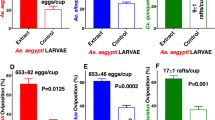Abstract
THE insecticides used in control operations against tsetse flies (Glossina spp.) have so far been almost exclusively organo-chlorine compounds, which kill the adult insect. Because of the possibility of the development of resistance to these compounds and as they may eventually become unavailable or unacceptable because of their persistence in the environment, a variety of possible new insecticides for tsetse control have been evaluated1. Dimilin, diflubenzuron, (N-{{(4-chlorophenyl)amino }carbonyl }-2,6-difluorobenzamide), is one of a range of insect growth regulators (IGRs) which interfere with chitin synthesis2,3 and, specifically, when applied to the adult female, inhibit egg hatch. Such effects have been reported for many pest insects, including a number of oviparous species of Diptera such as the house fly, Musca domestica L.4, stable fly, Stomoxys calcitrans L.4, horn fly, Haematobia irritans L.5, black fly, Simulium vittatum Zetterstedt6, various mosquitoes7 and chironomid midges8. Results reported here indicate the potential of a new range of compounds such as diflubenzuron which might be employed against Glossina in the future and which, following application to the adult female fly, act as a larvicide.
This is a preview of subscription content, access via your institution
Access options
Subscribe to this journal
Receive 51 print issues and online access
$199.00 per year
only $3.90 per issue
Buy this article
- Purchase on Springer Link
- Instant access to full article PDF
Prices may be subject to local taxes which are calculated during checkout
Similar content being viewed by others
References
Hadaway, A. B., Barlow, F., Turner, C. R. & Flower, L. S. Pestic. Sci. 8, 172–176 (1977).
Wellinga, K., Mulder, R., Daalen, J. J. van J. agric. Fd Chem. 21, 348–354 (1973).
Post, L. C. & Vincent, W. R. Naturwissenschaften 60, 431–432 (1973).
Wright, J. E. & Spates, G. E. J. econ. Ent. 69, 365–368 (1976).
Wright, J. E. & Harris, R. L. J. econ. Ent. 69, 728–730 (1976).
Lacey, L. A. & Mulla, M. S. J. econ. Ent. 70, 369–373 (1977).
Mulla, M. S. & Darwazeh, H. A. J. econ. Ent. 69, 309–312 (1976).
Mulla, M. S., Kramer, W. L. & Barnard, D. R. J. econ. Ent. 69, 285–291 (1976).
Nash, T. A. M., Jordan, A. M. & Boyle, J. A. Ann. trop. Med. Parasit. 62, 336–341 (1968).
Tech. Rep. WHO No. 191, (1960).
Denlinger, D. L. Nature 253, 347–348 (1975).
Neisess, J., Markin, G. P. & Schaefer, R. J. econ. Ent. 69, 783–786 (1976).
Author information
Authors and Affiliations
Rights and permissions
About this article
Cite this article
JORDAN, A., TREWERN, M. Larvicidal activity of diflubenzuron in the tsetse fly. Nature 272, 719–720 (1978). https://doi.org/10.1038/272719a0
Received:
Accepted:
Issue Date:
DOI: https://doi.org/10.1038/272719a0
This article is cited by
-
10.1007/BF00195577
CrossRef Listing of Deleted DOIs (2011)
-
10.1007/BF00343556
CrossRef Listing of Deleted DOIs (2011)
-
Uptake and distribution of three insect growth regulators — diflubenzuron, flucycloxuron and halofenozide — in pupae and adults ofTenebrio molitor
Phytoparasitica (2006)
Comments
By submitting a comment you agree to abide by our Terms and Community Guidelines. If you find something abusive or that does not comply with our terms or guidelines please flag it as inappropriate.


